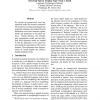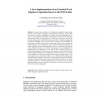175 search results - page 6 / 35 » A Probability Model to Improve Word Alignment |
CORR
1998
Springer
13 years 7 months ago
1998
Springer
Abstract. In many applications of natural language processing (NLP) it is necessary to determine the likelihood of a given word combination. For example, a speech recognizer may ne...
COLING
2010
13 years 2 months ago
2010
We present an unsupervised word segmentation model for machine translation. The model uses existing monolingual segmentation techniques and models the joint distribution over sour...
FLAIRS
2011
12 years 11 months ago
2011
This paper considers a scenario when we are given almost perfect knowledge about bilingual terminology in terms of a test corpus in Statistical Machine Translation (SMT). When the...
IICAI
2007
13 years 9 months ago
2007
In recent years statistical word alignment models have been widely used for various Natural Language Processing (NLP) problems. In this paper we describe a platform independent and...
ACL
2006
13 years 9 months ago
2006
This paper compares different bilexical tree-based models for bilingual alignment. EM training for the new model benefits from the dynamic programming "hook trick". The ...


